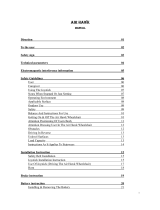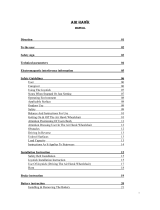
Full manual available to download from: www.Ares-RC.com
Quick-Start Guide
Product specications are subject to change without notice.
Due to ongoing development, the actual product may vary from
images shown.
This product contains chemicals known to the State of California
to cause cancer, birth defects and other reproductive harm.
This product is not a toy! (14+) Recommended for ages 14 and
up. Adult supervision required for ages under 18 years old.
Contains small parts, keep out of reach of children 3 years of
age and younger.
To download the full Owner’s Manual &
Technical Information Guide, please visit
www.Ares-RC.com or scan the QR code with
your smart phone.
Distributed in the UK by:
J Perkins Distribution Ltd,
Lenham,
Kent, UK
ME17 2DL.
www.jperkins.com
Distributed in Australia by:
Model Engines (Aust.) Pty. Ltd.,
Unit 1, 158-168 Browns Road,
Noble Park,
Victoria,
3174,
Australia.
www.modelengines.com.au
Ph (03) 8793 5555
Distributed in the US by:
Firelands Customer Service/Product Support
1133 Libra Drive, Lincoln, NE 68512
www.relandsgroup.com
1-800-205-6773
customerservice@relandsgroup.com
V Hawk RTF AZSZ2700
V Hawk PTF AZSZ2701
V Hawk RFR AZSZ2702
MADE IN CHINA

QUICK-START GUIDE
Full manual available to download from: www.Ares-RC.com
1
Remove the components from
the box and ensure you have the
following parts: Fuselage and wing
assembly, tail n, foam cement,
undercarriage set, propeller set
(x4) with prop adapters, spare
propellers (x4), transmitter, Li-Po
battery and charger.
This Quick Start guide is written for the RTF (Ready to Fly) version of the V-Hawk X4.
If you have the PTF (Pair to Fly) version, your model comes complete with a pre-installed
Hitec Red-enabled receiver. Simply pair (connect) with your existing 2.4GHz Hitec or Hitec
Red-enabled transmitter using the pairing guide on last page of this Quick Start guide.
A full instruction manual is available to download from www.ares-rc.com
2
Glue the tail n to the rear of the fuselage
using the contact adhesive supplied. Apply to
the mating surfaces, press the parts together
to spread the glue evenly across the joint,
then detach the n and leave for 5 or 10
minutes until the glue is dry. Reattach the n
and press rmly to ensure a good bond.
3
Slot the wire undercarriage units
into the sockets on the fuselage
underside.
4
Read and fully understand the Li-Po care and
safety precautions in the full online manual
at www.ares-rc.com and never leave Li-Po
batteries unattended whilst charging. Fully
charge the 4S 1300mAh Li-Po in accordance
with guidelines and instructions supplied with
your battery charger.

Full manual available to download from: www.Ares-RC.com
5
Use hook and loop tape to install
the ight battery as far forward as
possible.
6
Remove the transmitter battery
cover and insert four AA alkaline
cells.
7
Switch ON your transmitter, ensure
the LED is lit solid red, center
all the digital trim levers then
move the throttle stick to the low
position.
8
Connect the battery to the ESC. A series of
4 audible beeps will be heard indicating
that the ESC is armed and operational. Stow
the leads carefully within the fuselage and
replace the canopy hatch. In the unlikely
event that the servos do not operate see the
PAIRING instructions at the end of this guide.
9
With the sticks and trims centered check that
the elevon control surfaces are in the neutral
position. If not unhitch the clevis and screw
it in or out on the threaded portion of the
pushrod until the control surface is properly
centered. When nished, snap it back in
position on the outer hole of the horn.

QUICK-START GUIDE
Full manual available to download from: www.Ares-RC.com
11
With motors rotated to the forward
ying position pull the elevator
stick back and check that the
both elevons move in an upward
direction. Push the elevator stick
forward and check that the elevons
move in a downward direction.
12
With motors still in the forward
ying position move the aileron
stick to the right and check that
the right-hand elevon moves in
an upward direction whilst the
left-hand elevon moves downward.
Moving the aileron stick to the left
will have the opposite effect.
13
With motors still in the forward
ying position operate the 5th
channel function and check that
they smoothly transition to the
vertical hovering position. Note that
in this conguration movement of
the elevons will be restricted in all
directions.
With propellers removed, open
the throttle slowly and check that
all four motor shafts turn in the
correct direction – see STEP 14.
10

Full manual available to download from: www.Ares-RC.com
14
Remove the canopy, unplug the
Li-Po battery and switch OFF the
transmitter. Check the image here
noting the correct location of the
four propellers each marked either
A or B.
15
Slide each propeller and clamp-
style prop adaptor over its
respective motor shaft, and push
it as far down as it will go. Insert
a neatly tting torque bar through
the hole in the spinner nut and
rmly tighten it noting that a loose
propeller has the potential to cause
severe injury.
16
With the Li-Po battery located and
the canopy hatch tted check that
that the balance point is between
120 and 135mm from the leading
edge of the front wing.

QUICK-START GUIDE
Full manual available to download from: www.Ares-RC.com
17
With the aircraft sitting on a at/
level surface, move the throttle
stick to the low position, switch
ON the transmitter once more
and connect the battery and
ESC whilst keeping well clear of
the live propellers. Leave your
V-Hawk undisturbed until the
on-board gyros calibrate. The
process is conrmed when the
motors rotate from their 45 degree position to either the hover or the forward
ight position, this depending on your Channel 5 switch position. Ret the
canopy hatch and check once more that the control surfaces move in the
correct manner. Your V-Hawk X4 is now ready to y.
For a guide to the basic ight operation of your V-Hawk X4 please refer to the
full online instruction manual at www.ares-rc.com.

Full manual available to download from: www.Ares-RC.com
PAIRING GUIDE
Transmitter Pairing
1
If previously tted, remove the
V-Hawk’s propellers during the
receiver pairing process. Place your
transmitter and receiver/model
within 1m of each other.
2
Switch the transmitter ON
and follow the pairing/binding
procedure applicable to your radio
set.
3
4
Switch the KA-6 reciver ON. The
LED will initially ash red/blue
then change to fast-ashing red.
Follow the screen prompts or
the guidance detailed in your
transmitter’s pairing instructions,
re-booting both the transmitter and
receiver as necessary. Pairing will
be complete when the ashing red
LED on the KA-6 receiver turns to solid red.
If using a Hitec air radio that
supports both OPTIMA and MINIMA
receivers, make sure to select the
MINIMA option for pairing then
put your transmitter into pair/bind
mode.
If you’re completing the PTF (Pair to Fly) version, or in the unlikely event that your
V-Hawk X4’s RTF radio does not operate straight out of the box, use this guide to pair
your transmitter to the included KA-6 receiver. Once the receiver has been paired to the
transmitter it should not be necessary to complete this procedure again as the ID code will
be stored in the receiver. For full pairing information and that relating specically to the
KA-6 transmitter see the online manual at www.Ikonnik-rc.com
Fail-safe set button
(see full manual online for use)

QUICK-START GUIDE
Full manual available to download from: www.Ares-RC.com
NOTE: If you experience any problems,
please consult online troubleshooting guide.
/





